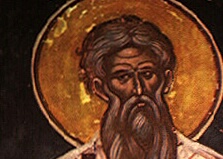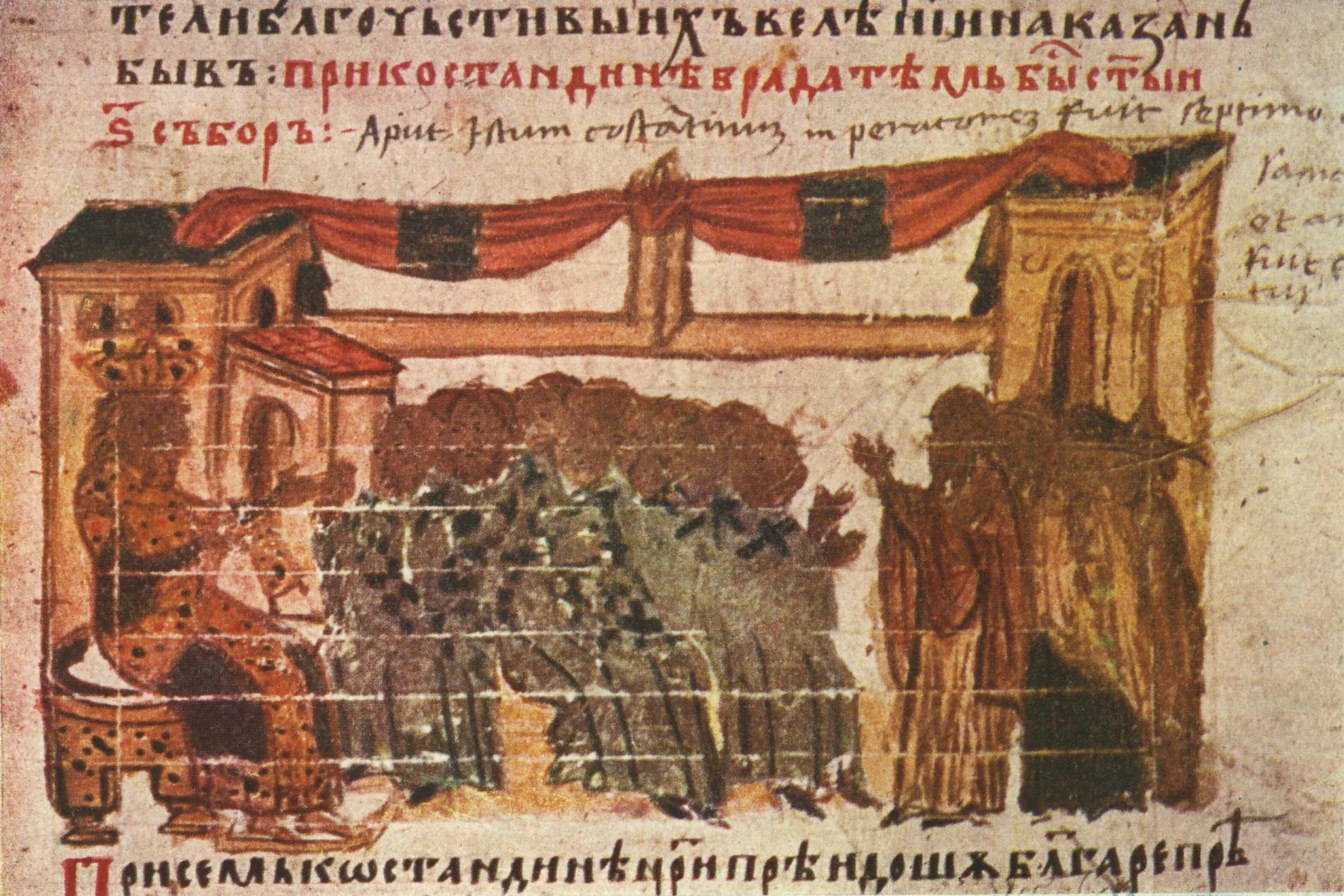|
Asekretis
The term ''asekretis'' ( gr, ἀσηκρῆτις, asēkrētis, invariable form) designated a senior class of secretaries in the Byzantine imperial court in the 6th–12th centuries. The term is derived from the Latin ''a secretis'', and in its full form was "''asekretis'' of the court" (ἀσηκρῆτις τῆς αὺλῆς, ''asēkrētis tēs aulēs''). It seems to be an innovation of the 6th century, as the contemporary historian Procopius of Caesarea found it necessary to explain it to his readers. Modern scholars have sometimes assumed that it dates to the 4th century, but the only reference to it, in the acts of the Council of Chalcedon, actually dates from a 6th-century translation of the document. The ''asekretis'' succeeded the '' referendarii'' as the senior-most members of the imperial secretariat, above the '' notarii''. Some of them were attached to the praetorian prefectures. Seals of the office's holders survive from the 6th and 7th centuries, while a referenc ... [...More Info...] [...Related Items...] OR: [Wikipedia] [Google] [Baidu] |
Protasekretis
The or ( gr, πρωτ ��σηκρῆτις), Latinized as or , was a senior official in the Byzantine bureaucracy. The title means "first ", illustrating his position as the head of the order of the , the senior class of imperial notaries. The post evolved gradually. The first are attested from the 6th century, and several Ecumenical Patriarchs of Constantinople and one emperor, Anastasios II (), were drawn from their ranks. Aside from possibly anachronistic references to Maximus the Confessor being a under Emperor Heraclius (), the earliest confirmed occurrence (as ) comes from the ''Liber Pontificalis'' for the year 756.. As head of the imperial chancery (the effective successor of the late Roman ), the position was highly influential: in the 899 ''Kletorologion'' of Philotheos, a list of court precedence of officials, he is placed seventh among the , the financial ministers of the state. From documents and sigillographic evidence, the holders of the office held the dignities ... [...More Info...] [...Related Items...] OR: [Wikipedia] [Google] [Baidu] |
Nikephoros I Of Constantinople
Nikephoros I or Nicephorus I (c. 758 – 5 April 828) was a Byzantine writer and patriarch of Constantinople from 12 April 806 to 13 March 815. Life He was born in Constantinople as the son of Theodore and Eudokia, of a strictly Orthodox family, which had suffered from the earlier Iconoclasm. His father Theodore, one of the secretaries of Emperor Constantine V, had been scourged and banished to Nicaea for his zealous support of Iconodules, and the son inherited the religious convictions of the father. Nevertheless, he entered the service of the Empire, became cabinet secretary (''asekretis''), and under Irene took part in the synod of 787 as imperial commissioner. He then withdrew to one of the cloisters that he had founded on the eastern shore of the Bosporus, until he was appointed director of the largest home for the destitute in Constantinople c. 802. After the death of the Patriarch Tarasios of Constantinople, although still a layman, he was chosen patriarch by the wis ... [...More Info...] [...Related Items...] OR: [Wikipedia] [Google] [Baidu] |
Tarasios Of Constantinople
Saint Tarasios (also Saint Tarasius; el, Ἅγιος Ταράσιος; c. 730 – 25 February 806) was the Ecumenical Patriarch of Constantinople from 25 December 784 until his death on 25 February 806. Background Tarasios was born and raised in the city of Constantinople. A son of a high-ranking judge, Tarasios was related to important families, including that of the later Patriarch Photios the Great. Tarasios had embarked on a career in the secular administration and had attained the rank of senator, eventually becoming imperial secretary (''asekretis'') to the Emperor Constantine VI and his mother, the Empress Irene. Originally he embraced Iconoclasm, but later repented, resigned his post, and retired to a monastery, taking the Great Schema (monastic habit). Since he exhibited both Iconodule sympathies and the willingness to follow imperial commands when they were not contrary to the faith, he was selected as Patriarch of Constantinople by the Empress Irene in 784, even thou ... [...More Info...] [...Related Items...] OR: [Wikipedia] [Google] [Baidu] |
Anastasios II
Anastasius II ( la, Artemius Anastasius; el, Ἀρτέμιος Ἀναστάσιος, Artémios Anastásios, died 719) was the Byzantine emperor from 713 to 715. During his reign he reversed his predecessor's decision to appoint a Monothelete Patriarch of Constantinople. He instead re-elevated Orthodoxy in Constantinople by appointing Germanus I to the position in order to gain Pope Constantine's favor. His reign was spent attempting to reinforce the Empire and bring it into an era of stability. He was deposed by Theodosius during the Byzantine campaign against the Umayyad Caliphate in 715. Four years later, in 719, Anastasius would launch a rebellion against Emperor Leo III with the intent to reclaim the throne. He initially received support in the form of soldiers and funds from Tervel of Bulgaria. But once Anastasius failed to enter Constantinople, the Bulgar forces he had brought complied with a request from Leo III to turn Anastasius and his allies over. Anastasius woul ... [...More Info...] [...Related Items...] OR: [Wikipedia] [Google] [Baidu] |
Seal Of The Hypatos And Basilikos Asekretis Ioannes
Seal may refer to any of the following: Common uses * Pinniped, a diverse group of semi-aquatic marine mammals, many of which are commonly called seals, particularly: ** Earless seal, or "true seal" ** Fur seal * Seal (emblem), a device to impress an emblem, used as a means of authentication, on paper, wax, clay or another medium (the impression is also called a seal) * Seal (mechanical), a device which helps prevent leakage, contain pressure, or exclude contamination where two systems join Arts, entertainment and media * ''Seal'' (1991 album), by Seal * ''Seal'' (1994 album), sometimes referred to as ''Seal II'', by Seal * ''Seal IV'', a 2003 album by Seal * ''Seal Online'', a 2003 massively multiplayer online role-playing game Law * Seal (contract law), a legal formality for contracts and other instruments * Seal (East Asia), a stamp used in East Asia as a form of a signature * Record sealing Military * ''Fairey Seal'', a 1930s British carrier-borne torpedo bomber aircra ... [...More Info...] [...Related Items...] OR: [Wikipedia] [Google] [Baidu] |
Grammatikos
Grammaticus is the Latin word for grammarian; see Grammarian (Greco-Roman world). It is also used to refer to a Roman patrician school. As an agnomen, it may refer to: * Ammonius Grammaticus (4th century), Greek grammarian * Diomedes Grammaticus (4th century), Latin grammarian * Musaeus Grammaticus (6th century), Greek poet * Virgilius Maro Grammaticus (7th century), early medieval Latin writer * John VII of Constantinople, known as John VII Grammaticus (9th century), Ecumenical Patriarch of Constantinople * Ælfric of Eynsham, known in Latin as Alfricus Grammaticus (10th century), Anglo-Saxon abbot and author * Saxo Grammaticus (circa 1150-1220), Danish medieval historian As a pseudonym: * Edward Musgrave Blaiklock Edward Musgrave Blaiklock (6 July 1903 – 26 October 1983) was chair of classics at the University of Auckland from 1947 to 1968, and champion of Christian apologetic literature in New Zealand from the 1950s until his death in 1983. Biography ..., (1903-1983), B ... [...More Info...] [...Related Items...] OR: [Wikipedia] [Google] [Baidu] |
Patriarchs Of Constantinople
This is a list of the Patriarchs of Constantinople. Bishops of Byzantium (until 330) *1. St. Andrew the Apostle (38), founder *2. St. Stachys the Apostle (38–54) *3. St. Onesimus (54–68) *4. Polycarpus I (69–89) *5. Plutarch (89–105) *6. Sedecion (105–114) *7. Diogenes (114–129) *8. Eleutherius (129–136) *9. Felix (136–141) *10. Polycarpus II (141–144) *11. Athenodorus (144–148) *12. Euzois (148–154) *13. Laurence (154–166) *14. Alypius (166–169) *15. Pertinax (169–187) *16. Olympianus (187–198) *17. Mark I or Marcus I (198–211) *18. Philadelphus (211–217) *19. Cyriacus I (217–230) *20. St. Castinus (230–237) *21. Eugenius I (237–242) *22. Titus (242–272) *23. Dometius (272–284) *24. Rufinus I (284–293) *25. Probus (293–306) *26. St. Metrophanes (306–314) *27. St. Alexander (314–337) Archbishops of Constantinople (330–451) *28. St. Paul I ("the Confessor") (337–339) *29. Eusebius of Nicomedia (339– ... [...More Info...] [...Related Items...] OR: [Wikipedia] [Google] [Baidu] |
Spatharios
The ''spatharii'' or ''spatharioi'' (singular: la, spatharius; el, σπαθάριος, literally "spatha-bearer") were a class of Late Roman imperial bodyguards in the court in Constantinople in the 5th–6th centuries, later becoming a purely honorary dignity in the Byzantine Empire. History Originally, the term was probably applied to both private and imperial bodyguards.. The original imperial ''spatharioi'' were probably or later became also the eunuch '' cubicularii'' (Greek: ''koubikoularioi''), members of the ''sacrum cubiculum'' (the imperial "sacred chamber") charged with military duties. They are attested from the reign of Emperor Theodosius II (r. 408–450), where the eunuch Chrysaphius held the post. The existence of the specific title of ''spatharokoubikoularios'' for eunuchs in 532 probably suggests the existence by then of other, non-eunuch, ''spatharioi'' in imperial service. The various generals and provincial governors also maintained military attendants calle ... [...More Info...] [...Related Items...] OR: [Wikipedia] [Google] [Baidu] |
Protospatharios
''Prōtospatharios'' ( el, πρωτοσπαθάριος) was one of the highest court dignities of the middle Byzantine period (8th to 12th centuries), awarded to senior generals and provincial governors, as well as to foreign princes. History The meaning of the title, "first ''spatharios''", indicates its original role as leader of the order (''taxis'') of the ''spatharioi'', the imperial bodyguards, was already attested in the 6th century. Probably under the Heraclians, the rank became an honorary dignity (Greek: δια βραβείου ἀξία, ''dia brabeiou axia''), and was henceforth bestowed to high-ranking theme commanders, senior court officials, and allied rulers.. The first concrete reference to a ''prōtospatharios'' occurs in the ''Chronicle'' of Theophanes the Confessor, who records "Sergios, ''prōtospatharios'' and '' stratēgos'' of Sicily" in 718. In the late 9th century, the ''prōtospatharios'' is recorded as ranking below the ''patrikios'' and above the ''di ... [...More Info...] [...Related Items...] OR: [Wikipedia] [Google] [Baidu] |
Third Council Of Constantinople
The Third Council of Constantinople, counted as the Sixth Ecumenical Council by the Eastern Orthodox and Catholic Churches, as well by certain other Western Churches, met in 680–681 and condemned monoenergism and monothelitism as heretical and defined Jesus Christ as having two energies and two wills (divine and human).George Ostrogorsky, ''History of the Byzantine State'' (Rutgers University Press, 1995), 127. Background The council settled a set of theological controversies that went back to the sixth century but had intensified under the emperors Heraclius () and Constans II (). Heraclius had set out to recover much of the part of his empire lost to the Persians and had attempted to bridge the controversy with monophysitism, which was particularly strong in Syria and Egypt, by proposing a moderate theological position that had as good support in the tradition as any other. The result was first monoenergism, i.e. that Christ, though existing in two natures (divine and h ... [...More Info...] [...Related Items...] OR: [Wikipedia] [Google] [Baidu] |
Uninflected Word
In linguistic morphology, an uninflected word is a word that has no morphological markers (inflection) such as affixes, ablaut, consonant gradation, etc., indicating declension or conjugation. If a word has an uninflected form, this is usually the form used as the lemma for the word. In English and many other languages, uninflected words include prepositions, interjections, and conjunctions, often called invariable words. These cannot be inflected under any circumstances (unless they are used as different parts of speech, as in "ifs and buts"). Only words that cannot be inflected at all are called "invariable". In the strict sense of the term "uninflected", only invariable words are uninflected, but in broader linguistic usage, these terms are extended to be inflectable words that appear in their basic form. For example, English nouns are said to be uninflected in the singular, while they show inflection in the plural (represented by the affix ''-s/-es''). The term "uninflected ... [...More Info...] [...Related Items...] OR: [Wikipedia] [Google] [Baidu] |



